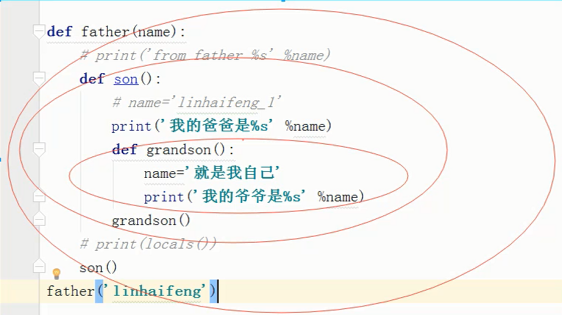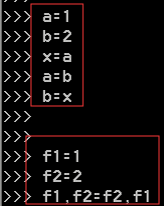原文:https://www.cnblogs.com/linhaifeng/articles/6140395.html
1.装饰器
器即函数
装饰即修饰,意指为其他函数添加新功能
装饰器定义:本质就是函数,功能是为其他函数添加新功能
2.装饰器原则
1.不修改被装饰函数的源代码(开放封闭原则)
2.为被装饰函数添加新功能后,不修改被修饰函数的调用方式
3.实现装饰器需要哪些知识
装饰器=高阶函数+函数嵌套+闭包
4.高阶函数
高阶函数定义:
1.函数接收的参数是一个函数名
2.函数的返回值是一个函数名
3.满足上述条件任意一个,都可称之为高阶函数
import time
def foo():
time.sleep(3)
print('来自foo')
#不修改foo源代码
#不修改foo调用方式
#多运行了一次,不合格
# def timer(func):
# start_time=time.time()
# func()
# stop_time = time.time()
# print('函数运行时间是 %s' % (stop_time-start_time))
# return func
# foo=timer(foo)
# foo()
#没有修改被修饰函数的源代码,也没有修改被修饰函数的调用方式,但是也没有为被修饰函数添加新功能
def timer(func):
start_time=time.time()
return func
stop_time = time.time()
print('函数运行时间是 %s' % (stop_time-start_time))
foo=timer(foo)
foo()
5.函数嵌套
指在一个函数里又定义了一个函数
def father(name):
print('from father %s' %name)
def son():
print('from son')
def grandson():
print('from grandson')
grandson()
son()
father('ray')
6.闭包
闭包:在一个作用域里放入定义变量,相当于打了一个包。ps:一个作用域的范围就是一个函数。

7.装饰器例子
无参装饰器=高级函数+函数嵌套
语法糖@,调用装饰器
基本实现
import time
def timmer(func): #func=test
def wrapper():
# print(func)
start_time=time.time()
func() #就是在运行test()
stop_time = time.time()
print('运行时间是%s' %(stop_time-start_time))
return wrapper
@timmer #test=timmer(test)
def test():
time.sleep(3)
print('test函数运行完毕')
test()
# res=timmer(test) #返回的是wrapper的地址
# res() #执行的是wrapper()
# test=timmer(test) #返回的是wrapper的地址
# test() #执行的是wrapper()
# @timmer 就相当于 test=timmer(test)
加返回值(res = func())
import time
def timmer(func): #func=test
def wrapper():
start_time=time.time()
res=func() #就是在运行test()
stop_time = time.time()
print('运行时间是%s' %(stop_time-start_time))
return res
return wrapper
@timmer #test=timmer(test)
def test():
time.sleep(3)
print('test函数运行完毕')
return '这是test的返回值'
res=test() #就是在运行wrapper
print(res)
加参数
import time
def timmer(func): #func=test1
def wrapper(*args,**kwargs): #test('linhaifeng',age=18) args=('linhaifeng') kwargs={'age':18}
start_time=time.time()
res=func(*args,**kwargs) #就是在运行test() func(*('linhaifeng'),**{'age':18})
stop_time = time.time()
print('运行时间是%s' %(stop_time-start_time))
return res
return wrapper
# @timmer #test=timmer(test)
def test(name,age):
time.sleep(3)
print('test函数运行完毕,名字是【%s】 年龄是【%s】' %(name,age))
return '这是test的返回值'
@timmer
def test1(name,age,gender):
time.sleep(1)
print('test1函数运行完毕,名字是【%s】 年龄是【%s】 性别【%s】' %(name,age,gender))
return '这是test的返回值'
# res=test('linhaifeng',age=18) #就是在运行wrapper
# # print(res)
# test1('alex',18,'male')
test1('alex',18,'male')
8.模拟网站登录例子(带参数验证功能装饰器)
user_list=[
{'name':'alex','passwd':'123'},
{'name':'linhaifeng','passwd':'123'},
{'name':'wupeiqi','passwd':'123'},
{'name':'yuanhao','passwd':'123'},
]
current_dic={'username':None,'login':False}
def auth(auth_type='filedb'):
def auth_func(func):
def wrapper(*args,**kwargs):
print('认证类型是',auth_type)
if auth_type == 'filedb':
if current_dic['username'] and current_dic['login']:
res = func(*args, **kwargs)
return res
username=input('用户名:').strip()
passwd=input('密码:').strip()
for user_dic in user_list:
if username == user_dic['name'] and passwd == user_dic['passwd']:
current_dic['username']=username
current_dic['login']=True
res = func(*args, **kwargs)
return res
else:
print('用户名或者密码错误')
elif auth_type == 'ldap':
print('鬼才特么会玩')
res = func(*args, **kwargs)
return res
else:
print('鬼才知道你用的什么认证方式')
res = func(*args, **kwargs)
return res
return wrapper
return auth_func
@auth(auth_type='filedb') #auth_func=auth(auth_type='filedb')-->@auth_func 附加了一个auth_type --->index=auth_func(index)
def index():
print('欢迎来到京东主页')
@auth(auth_type='ldap')
def home(name):
print('欢迎回家%s' %name)
#
@auth(auth_type='sssssss')
def shopping_car(name):
print('%s的购物车里有[%s,%s,%s]' %(name,'奶茶','妹妹','娃娃'))
# print('before-->',current_dic)
# index()
# print('after--->',current_dic)
# home('产品经理')
shopping_car('产品经理')
9.解压序列
例:a,*_,c = x ,a是开头值,c是结尾值,下划线是中间的值。等同于x[0],x[-1].

两个效果一样,下面的更方便。
